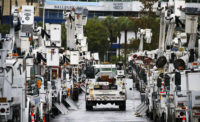Efforts to ease congested roadways in some of Florida’s fastest-growing communities may get a boost with a new legislative package that aims to fast-track 20 priority projects with a projected $7-billion state funding boost.
Through the Moving Florida Forward plan, if passed by the state legislature, Florida intends to lnvest $4 billion now from a surplus in the state general fund, and for the next four years, redirect $131 million annually to Florida’s State Transportation Work Program while set to leverage the funds to add an estimated $3 billion more that would expedite 20 priority infrastructure projects, according to Gov. Ron DeSantis in an announcement Jan. 30.
“I think they’re using all the tools in the toolbox to get this program done,” says Ananth Prasad, Florida Transportation Builders Association president. “I think a $4-billion surplus redirect is huge.”
The plan would ease hurdles that normally slow infrastructure projects and allow the Florida Dept. of Transportation (FDOT) to focus on those set to ease congestion—aiming to deliver them more than a decade ahead of schedule, said the governor's office..
FDOT Secretary Jared Perdue says the infusion of funds would be the largest in his 20 years at the department, a needed investment to help relieve congestion in key corridors clogging up as Florida’s population grows.
“The governor asked us to come up with a plan to relieve congestion, and that’s what we did,” he says, pointing out that in the proposed 2023-24 state budget, DeSantis earmarks $14.7 billion for FDOT, its largest ever by $2 billion.
According to DeSantis’ office, Florida now has 22 million residents, with a tourism economy that it says brought 105 million visitors to the state in the first three quarters of 2022. For that year, the state topped the nation in net in-migration at 1.9%, the office claims, leaving the state infrastructure network supporting more people than ever.
More People, More Traffic
Florida’s population is expected to continue growing by an estimated 600 new residents per day for the next 30 years, according to FDOT, with some areas in the state experiencing 20% growth rates or higher.
“If you had a commute of 30 minutes that’s now all of a sudden an hour and a half of traffic, that’s taxing emotionally, mentally, financially,” Perdue says. “The centerpiece is to relieve that congestion.” As the state works to relieve congestion, it will upgrade roadways with safety, resilience, technology and workforce development in mind, part of FDOT's comprehensive approach to infrastructure, he adds.
Prasad, a former FDOT secretary, says he is confident that the Florida legislature, which convenes in March, will approve the plan, saying both Speaker of the House Paul Renner and Senate President Kathleen Passidomo support infrastructure investment as a core function of government.
The projects are truly needed but not funded, Prasad says, especially the improvements to Interstate 4 and Interstate 75 near Ocala. Traditional revenue streams could mean decades before these projects come to fruition, he adds.
“We’re taking projects that would normally take 15-20 years to deliver and advancing them into the next four years,” Perdue says. He adds that they "are already prioritized and in the pipeline, but at various stages.”
All the projects are at a critical stage in that process, he adds, already prioritized by local agencies. If the plan is approved, they would be included in FDOT’s existing work plan over the next four years.
Contractor supply chain and workforce issues remain, Prasad says, but the answer iis not to wait while people sit in traffic.
“Not doing anything is the worst answer in a growing state like Florida,” he says.
Those issues are on Perdue’s radar as well, who says he’s fully confident in FDOT’s ability to rise to the challenge. Workforce development is a critical focus of FDOT, he says, and after years of a nationwide supply chain crisis, the department is looking to provide Florida the means for a healthy, solvent and resilient supply chain.
“I think it’s an incredible opportunity,” Perdue says. “It’s certainly going to take a lot of intensity, focus, knowledge and experience to deliver.”
Focusing on I-4, I-75
The project map on the Moving Florida Forward website shows the 20 projects spread across the state, with a focus on ongoing work to improve I-4, which runs from Tampa in the southwest, through Orlando and to Daytona Beach on the eastern coast. Four of the 20 projects are I-4 projects, which together constitute roughly half of the $7 billion and include the three largest projects on the list.
At $1.4 billion, the largest is the I-4 reconstruction through Osceola County, from Champions Gate to Osceola Parkway, to accommodate three traffic lanes, auxiliary lanes and two special use lanes in the eastbound and westbound directions.
The second largest, set for construction in 2027, is the $1.3-billion Poinciana Parkway Extension Connector. Also in Osceola County, the project will construct a new roadway extending roughly four miles and including a new intersection with I-4.
The third is a $635-million effort to reconstruct the interstate, also with work to start in 2027, to accommodate three general-use lanes, auxiliary lanes and two special-use lanes in both directions from U.S. 27 in Polk County, to Champions Gate in Osceola County, where the $1.4-billion project begins.
With addition of a $197-million project to rebuild in 2024 the interchange of I-4 and State Road 33 in Lakeland, Fla., he total cost of interstate work officials hope to fund with the new legislation tallies $3.53 billion.
Another $1.27 billion will go to four projects on I-75, including a $578-million project set to start in 2027 to add a travel lane to each direction over more than 20 miles of I-75 in Lee and Collier counties, taking that interstate from six to eight lanes.
Also included are the $479-million construction of auxiliary lanes in each direction of I-75 in Wildwood and Marion counties, including through Ocala, and the $23-million reconstruction of the Pine Ridge Road and I-75 interchange in Collier County into a diverging diamond.





Post a comment to this article
Report Abusive Comment